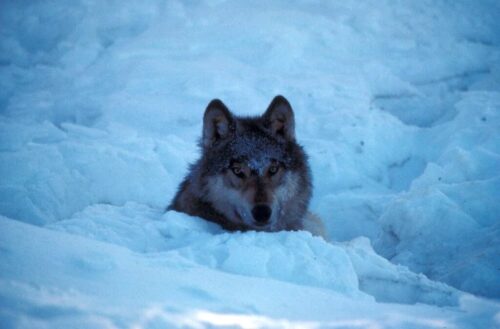
Prince Of Wales Island Wolf Trapping To Run 31 Days Until December 15

The following press release is courtesy of the Alaska Department of Fish and Game:
Wolf trapping season opening for 31 days in GMU 2
CRAIG, Alaska – Biologists with the Alaska Department of Fish and Game (ADF&G), in cooperation with the USDA Forest Service, have determined 31 days of trapping opportunity for wolf in Game Management Unit (GMU) 2 (Unit 2 in the federal regulations) will result in a sustainable level of harvest. State and federal wolf hunting seasons in GMU 2 opened on September 1. State and federal wolf hunting and trapping seasons will close at 11:59 p.m. on December 15, 2024.
Background
In 2019, ADF&G and the Alaska Board of Game changed the wolf harvest management strategy for GMU 2 after a two-year public engagement process. The new strategy annually adjusts season length relative to annual population estimates to maintain the wolf population within the objective range established by the Alaska Board of Game. ADF&G worked with the USFS, Fish and Game Advisory Committees, the Alaska Board of Game, the Federal Subsistence Regional Advisory Council, and trappers to develop a strategy that provides the flexibility and responsibility trappers desired, while sustainably managing wolf harvest.
ADF&G, with support from the Forest Service and cooperation from the Hydaburg Cooperative Association (HCA), estimates GMU 2 wolf abundance annually using a DNA-based mark-recapture technique. HCA experienced a staffing shortage in 2023 and was unable to fully contribute during the fall data collection effort. ADF&G and USFS collected wolf DNA samples using hair boards within ADF&G’s study area on northern and central Prince of Wales Island but was unable to expand sampling to help cover HCA’s area. ADF&G and designated sealers also collected tissue with the consent of
USDA is an equal opportunity provider, employer, and lender.
Clint Kolarich, Forest Supervisor (Acting) William Braun, Craig District Deputy Ranger USDA Forest Service; www.fs.usda.gov/tongass/
Forest Service
.
trappers from harvested wolves. DNA from tissue, along with accurate reports of when and where individual wolves were harvested, contributed to the population estimate.
Interpreting estimates and harvest
Estimating the GMU 2 wolf population takes about 10 months, so each year’s population estimate is used to inform harvest management in the following year. For example, the fall 2023 estimate informs GMU 2 wolf harvest management for this season. ADF&G and USFS establish annual hunting and trapping season closure dates to allow meaningful harvest opportunity while ensuring the population remains sustainable.
For fall 2023, ADF&G estimated the preharvest GMU 2 population to be 238 wolves with high confidence the true population size was within the range of 184 to 308 wolves (95% confidence interval). Managers base harvest management on the point estimate (238) because that is the value most likely to be correct given the data collected that year. However, managers recognize the true number of wolves is likely to be somewhat higher or lower and encourage the public to focus on long-term trends in abundance and harvest, rather than year-to-year changes in point estimates. Those trends indicate the population is stable and that harvest is being sustainably managed.
Sealing requirements
State sealing regulations for wolves harvested in GMU 2 require all hides to be sequentially numbered by the hunter or trapper, who must call the ADF&G Ketchikan office at (907) 225-2475 within 7 days of take to report the date and location of take, and all hides must be sealed within 15 days of take. These regulations are intended to provide more precise data for managers to use when calculating population estimates.
Federally qualified users harvesting wolves on federally managed land in GMU 2 may also seal wolves under federal subsistence regulations. Federal sealing regulations require wolves taken in GMU 2 to be sequentially numbered, marked with the date and location recorded by the trapper for each wolf, and all hides must be sealed within 15 days of take.
All GMU 2 trappers are encouraged to provide foreleg bones and small samples of muscle tissue and hide from each harvested wolf to ADF&G or designated sealers. Hide and tissue samples provide DNA for the population estimate. Foreleg bones are used to age harvested wolves. The proportion of harvested wolves in each age class (pup or adult) is an indicator of the population’s productivity and survival.
Fall 2024 Harvest Management
In GMU 2, most wolves are harvested by trapping, so state and federal managers regulate harvest by varying trapping opportunity. Determining the amount of trapping opportunity that will result in sustainable harvest involves analyzing recent population estimates, trends in trapper participation, documented harvest rates, public observations, and regulatory guidance. Harvest rate, or the number of wolves harvested per day of trapping season, is related to trapping effort, trapping conditions, and wolf abundance. Since initiating the current harvest management strategy in 2019, the daily harvest rate for GMU 2 wolves ranged from 2.0 to 3.2 wolves/day and averaged 2.4 wolves/day. Assuming an average
USDA is an equal opportunity provider, employer, and lender.
.
harvest rate, managers project that one month (31 days) of trapping opportunity is likely to result in harvest of about 74 wolves (31 days × 2.4 wolves/day = 74). However, managers recognize that the range of harvest rates documented in GMU 2 could also produce a harvest ranging from 62 to 99 wolves. Sustainability of the population is unlikely to be affected by harvest in a single year, so for 2024 managers consider harvest within that range sustainable.
Please call the ADF&G Ketchikan area office at 907-225-2475 for more information. For more information from the USDA Forest Service, please call Tongass Subsistence Coordinator Robert Cross at 907-723-8653. Maps of federal lands within GMU 2 are available at Forest Service offices. Maps and additional information on the Federal Subsistence Management Program can be found on the web at http://www.doi.gov/subsistence/index.cfm.



